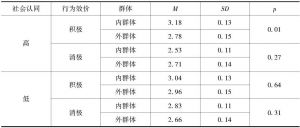论文
社会认同和群际威胁对群际态度的影响:基于语言群际偏差的指标
摘要
群际态度是群际关系的指示器,预测着群际行为与群际和谐。已有研究从社会认同、群际威胁等方面分别探讨了对群际态度的影响,存在两方面的不足。第一,关于社会认同如何影响群际态度,研究结果并不一致;第二,群际态度受多种因素交互影响并未涉及。基于此,本研究以大学生为研究对象,探讨社会认同、群际威胁对群际态度是否存在交互影响。研究结果显示,无群际威胁且社会认同程度高时,A文化群组被试表现了对内群体积极行为的偏爱,而B文化群组被试对内群体消极行为表现出了保护的倾向。研究结果提示群体成员对内群体的态度发生了变化,并未出现无条件的内群体偏爱。而当群际威胁出现时,无论社会认同程度高低,A文化群组被试表现出了显著的内群体偏爱和外群体偏见,提示A文化群组成员更容易表现出对内群体的亲社会行为;而B文化群组被试只有在高社会认同时,才会出现明显的内群体偏爱。因此,社会认同程度、群际威胁交互影响了人们的群际态度。这些研究结果对预测群际行为与群际和谐具有重要的启示意义。
作者
夏瑞雪 ,西北师范大学心理学院教授,硕士生导师,通信作者,E-mail:xrx9391@163.com
李诺 ,西北师范大学心理学院硕士研究生
牛百灵 ,兰州财经大学工商管理学院助教。
苏婉茹 ,西北师范大学心理学院硕士研究生。
李世峰 ,西北师范大学心理学院讲师。
邵宏宏 ,西北师范大学心理学院硕士研究生
刘冰华 ,西北师范大学心理学院硕士研究生。
Xia Ruixue
Li Nuo
Niu Bailing
Su Wanru
Li Shifeng
Shao Honghong
Liu Binghua
检索正文关键字
论文目录
-
一 问题提出
- (一)社会认同及其认同启动
- (二)群际威胁与社会认同威胁
- (三)群际态度的良好指标:语言群际偏差
-
二 研究方法
- (一)材料与问卷
- 1.语言群际偏差范式材料的修订
- 2.社会认同启动问卷的修订
- (二)假设与设计
- 1.假设
- 2.设计
- (三)研究一
- (四)研究二
- (一)材料与问卷
-
三 结果与分析
- (一)研究一
- (二)研究二
-
四 讨论
- (一)各美其美:内群体偏爱的稳健性
- (二)不过度保护内群体:群际态度的理性变化
- (三)群际威胁与社会认同交互影响群际态度
- 五 未来研究展望
查看更多>>>






